Conway polyhedron notation
Conway polyhedron notation is a textual notation for a certain class of convex polyhedra. Introduced by Conway, the applications of the notation to date have been mainly artistic, with the sculptor George Hart helping to popularize it.
The notation begins with "seed" polyhedron and and modifies it with a series of "operators" to obtain the desired polyhedron. These operators include standard ones such duals, truncation, and rectification, but also some more unusual ones. The notation itself is a string of mostly letters, representing the seed polyhedron as an uppercase letter on the right-hand side of the string, and operators as lowercase letters that are applied from right to left. For example, gtC is a cube (C) subjected to truncation (t) and then a "gyro" operation (g).
The notation can be straightforwardly generalized for nonconvex polyhedra by e.g. starting with a nonconvex seed. It has not been applied to dimensions other than 3.
Description[edit | edit source]
| Polyhedron | Tetrahedron | Octahedron | Cube | Icosahedron | Dodecahedron | n -gonal prism | n -gonal antiprism | n -gonal pyramid |

|

|

|
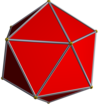
|

|

|
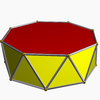
|

| |
| Seed letter | T | O | C | I | D | Pn | An | Yn |
| Operator name | Image | Conway notation | Notes |
|---|---|---|---|
| (Seed)
(Example: cube) |
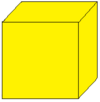
|
C | = dd |
| dual | 
|
dC | Faces replaced with vertices.
Vertices replaced with faces. |
| truncate | 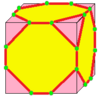
|
tC | Cuts off each vertex, with the cuts independent of one another.
A number after the t can mean "only apply this operator to vertices surrounded by this many edges." |
| ambo | 
|
aC | Rectification.
Cuts off each vertex, to the extent that the vertices of the cuts just touch each other. |
| expand; explode | 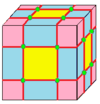
|
eC | Cantellation, which is the 3D form of expansion.
= aa, = do |
| bevel | 
|
bC | The 3D form of omnitruncation.
= ta, = dm |
| reflect | rC | Produces the mirror image of a chiral polyhedron.
Does not change achiral polyhedra. | |
| kis | 
|
kC | Puts a vertex in the middle of each face, and connects it with edges to the existing vertices.
This adds a pyramid to each face. This operator creates the tetrakis hexahedron from the cube. A number after the k can mean "only apply this operator to faces with this many edges." |
| join | 
|
jC | Creates quadrilateral faces.
The operator that creates the rhombic dodecahedron from the cube (or octahedron). = da |
| ortho | 
|
oC | Basically turns each n -gon face into n quadrilaterals.
The operator that creates the deltoidal icositetrahedron from the cube (or octahedron). = daa, = de |
| meta | 
|
mC | The operator that creates the
disdyakis dodecahedron from the cube (or octahedron). = kj, = db |
| snub | 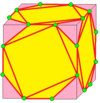
|
sC | Snubbing. Produces a chiral polyhedron.
= dg |
| gyro | 
|
gC | Basically turns each n -gon face into n pentagons. Chiral.
The operator that creates the pentagonal icositetrahedron from the cube (or octahedron). = ds |

The Platonic solids can be represented as Conway operators applied to prisms, antiprisms, and pyramids.
| T = | Y3 | ||||
| O = | aY3 | A3 | dP4 | ||
| C = | jY3 | dA3 | P4 | ||
| I = | sY3 | k5A5 | |||
| D = | gY3 | t5dA5 |
The Archimedean and Catalan solids can also be represented as Conway operators applied to Platonic solids. (Applying these to the tetrahedron might result in a Platonic solid.)
| truncate | rectify | truncate dual | cantellate | omnitrunate | snub | Catalan solid corresponding to one of these |
|---|---|---|---|---|---|---|
| t | a | td | e; aa | b; ta | s | d- followed by this operator(s) |
| kis of dual | "rhombic" solid | kis | "deltoidal" solid | disdyakis | "pentagonal" solid | Archimedean solid corresponding to one of these |
| kd; dt | j; da | k; dtd | o; daa | m; dta | g; ds | d- followed by this operator(s) |
The wide variety of possibilities by which new faces, edges, and vertices can be created and by which old ones can be removed may give rise to many different operators from different sources. Some are not default or standardized, and might have conflicting notation or might not be found in all implementations of the Conway notation.
| Operator name | Image | Notes |
|---|---|---|
| (Seed) | 
|
|
| zip | 
|
Bitruncation.
The operator that creates the truncated octahedron from the cube. = dk, = td |
| needle | 
|
The operator that creates the triakis octahedron from the cube.
= kd, = dt |
| chamfer | 
|
The operator that creates the chamfered cube from the cube. |
| propellor | 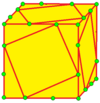
|
|
| whirl | 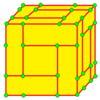
|
|
| loft | 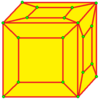
|
Equivalent to augmenting the faces with prisms. |
| lace | 
|
Equivalent to augmenting the faces with antiprisms. |
| quinto | 
|
External links[edit | edit source]
- Polyhédronisme, an interactive tool for exploring Conway notation
- PD: Polyhedron Generator, another interactive tool
- Hart, George. Conway Notation for Polyhedra, another interactive tool
- Wikipedia contributors. "Conway polyhedron notation".
- Weisstein, Eric W. "Conway Polyhedron Notation" at MathWorld.